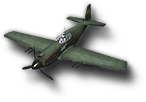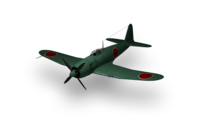Mitsubishi A7M Reppu
A7M
| 1330000 價格 |
| 280 生命值 |
| 3730 公斤重量 |
| 336.6 傷害 |
| 1354 飛行速度 |
| 580 公里/小時海平面上的最高速度 |
| 580 公里/小時最佳高度下的最高速度 |
| 1100 公尺理想高度 |
| 700 公里/小時最大俯衝速度 |
| 114 公尺/秒爬升率 |
| 90 公里/小時失速速度 |
| 312 公里/小時理想飛行速度 |
| 86.5 操控性 |
| 8 秒迴轉 360 度的平均時間 |
| 100 °/秒翻滾率 |
| 1556.6 機動性 |


引擎
| 階級 | 引擎 | 引擎輸出, 匹馬力 / 推力 | 類型 | 重量, 公斤 | 價格, |
|---|---|---|---|---|---|
| VII | NK9K | 1990 | 空冷式 | 830 | 50200 |
| VIII | MK9A | 2200 | 空冷式 | 1035 | 75600 |
| IX | MK9E | 2550 | 空冷式 | 1040 | 165000 |

機體
| 階級 | 機體 | 生命值 | 重量, 公斤 | 價格, |
|---|---|---|---|---|
| VI | A7M1 | 280 | 2600 | 72500 |
| VII | A7M2 | 300 | 2600 | 87000 |

裝於機翼的武器
| 階級 | 機槍 | 口徑 | 槍口初速, 公尺/秒 | 傷害 | 射擊速率, 發/分鐘 | 重量, 公斤 | 價格, |
|---|---|---|---|---|---|---|---|
| VII | 20 mm Type 99-2 Model 5 (翼) | 20 | 1600 | 110 | 400 | 90 | 53900 |
| VII | WEAPON_NAME_G20MM-TYPE-99-2-M5-K_SPEC_TOP_A7M_1 | 20 | 1600 | 110 | 400 | 90 | 53900 |

裝於機翼的武器
| 階級 | 機槍 | 口徑 | 槍口初速, 公尺/秒 | 傷害 | 射擊速率, 發/分鐘 | 重量, 公斤 | 價格, |
|---|---|---|---|---|---|---|---|
| VII | 20 mm Type 99-2 Model 4 (翼) | 20 | 1440 | 100 | 400 | 90 | 41300 |
| VII | 20 mm Type 99-2 Model 5 (翼) | 20 | 1600 | 110 | 400 | 90 | 53900 |
| VII | WEAPON_NAME_G20MM-TYPE-99-2-M5-K_SPEC_TOP_A7M_1 | 20 | 1600 | 110 | 400 | 90 | 53900 |

Compatible Equipment
Compatible Consumables
Historical Info
In April 1942, the development of the A6M3 and the 14-Shi interceptor was complete, and the Japanese Navy once again tasked Mitsubishi and Horikoshi's team with designing a new Zero successor to become the Navy Experimental 17-shi Ko (A) Type Carrier Fighter Reppu. In July 1942 the Navy issued specifications for the fighter: it had to fly faster than 345 kn (639 km/h) above 6,000 m, climb to 6,000 m in less than 6 minutes, be armed with two 20 mm cannon and two 13 mm machine guns, and retain the maneuverability of the A6M3.
As before, one of the main hurdles was engine selection. To meet the specifications the engine would need to produce at least 2,000 hp, which narrowed choices down to Nakajima's NK9 (Ha-45) or Mitsubishi's MK9 (Ha-43), which were both under development. The early NK9 had less output but was already approved by the Navy for use on the Yokosuka P1Y Ginga, while the larger MK9 promised more horsepower. With the larger, more powerful engine, wing loading became an issue. The Navy requested at most 150 kg/m², but wanted 130 kg/m² which complicated design considerations further. With the NK9 it could achieve 150 kg/m², but with the less power it would not meet the specifications for maximum speed. With the MK9 the engineers concluded it could fulfill the requirements; however, production of the MK9 was delayed compared to the NK9, and the Japanese Navy instructed Mitsubishi to use the NK9.
Work on the 17-Shi was further delayed by factories prioritizing A6M and Mitsubishi G4M production as well as further work on A6M variants and addressing Raiden issues. As a result, the 17-Shi, which became the A7M1, officially flew for the first time on 6 May 1944, four years after development started. The aircraft demonstrated excellent handling and maneuverability, but was underpowered as Mitsubishi engineers feared, and with a top speed similar to the A6M5 Zero. It was a disappointment, and the Navy ordered development to stop on 30 July 1944, but Mitsubishi obtained permission for development to continue using the Ha-43 engine, flying with the completed Ha-43 on 13 October 1944. The A7M2 now achieved a top speed of 628 km/h, while climb and other areas of performance surpassed the Zero, leading the Navy to change its mind and adopt the craft. The A7M2 was also equipped with automatic combat flaps, used earlier on the Kawanishi N1K-J, significantly improving maneuverability.
On June 1945, ace pilot Saburo Sakai was ordered to Nagoya to test the airplane. He declared it to be the fastest fighter he had ever seen, able to surpass anything on the air, Japanese or American. He claimed it could fly in circles, while ascending, around a Hellcat or a Mustang, and that engineers stated it could fight at up to 12,000 meters.
While it was hoped that the A7M would replace the A6M, production was disrupted by an earthquake on December 1944 in the Nagoya region, and Allied bombing raids on 11 March 1944, which caused the loss of full scale drawings and jigs for the Sam 12 (A7M2) and Ki-83. Only nine aircraf were completed by the end of the war. The type never saw combat.
| Fighters | IINakajima A4N • IIKawasaki Ki-10 • IIKawasaki Ki-5 • IINakajima Ki-8 • IIIMitsubishi A5M • IIIMitsubishi Ki-18 • IIINakajima Ki-27 • IIIMitsubishi Ki-33 • IVMitsubishi A6M1 Zero • IVNakajima Ki-43-I Hayabusa • VMitsubishi A6M2 Zero • VMitsubishi A6M3 (experimental) • VNakajima Ki-43-II Hayabusa • VIMitsubishi A6M5 Zero • VIKawasaki Ki-61 Hien • VIKawasaki Ki-88 • VIIMitsubishi A7M Reppu • VIINakajima Ki-84 Hayate • VIIIMitsubishi J8M Shusui • VIIITachikawa Ki-94-II • IXTachikawa Ki-162-I • XTachikawa Ki-162-III |
| Heavy Fighters | VKawasaki Ki-45 Toryu • VIKawasaki Ki-102 • VIIRikugun Ki-93 • VIITachikawa Ki-94-I |
| Attack Aircraft |
